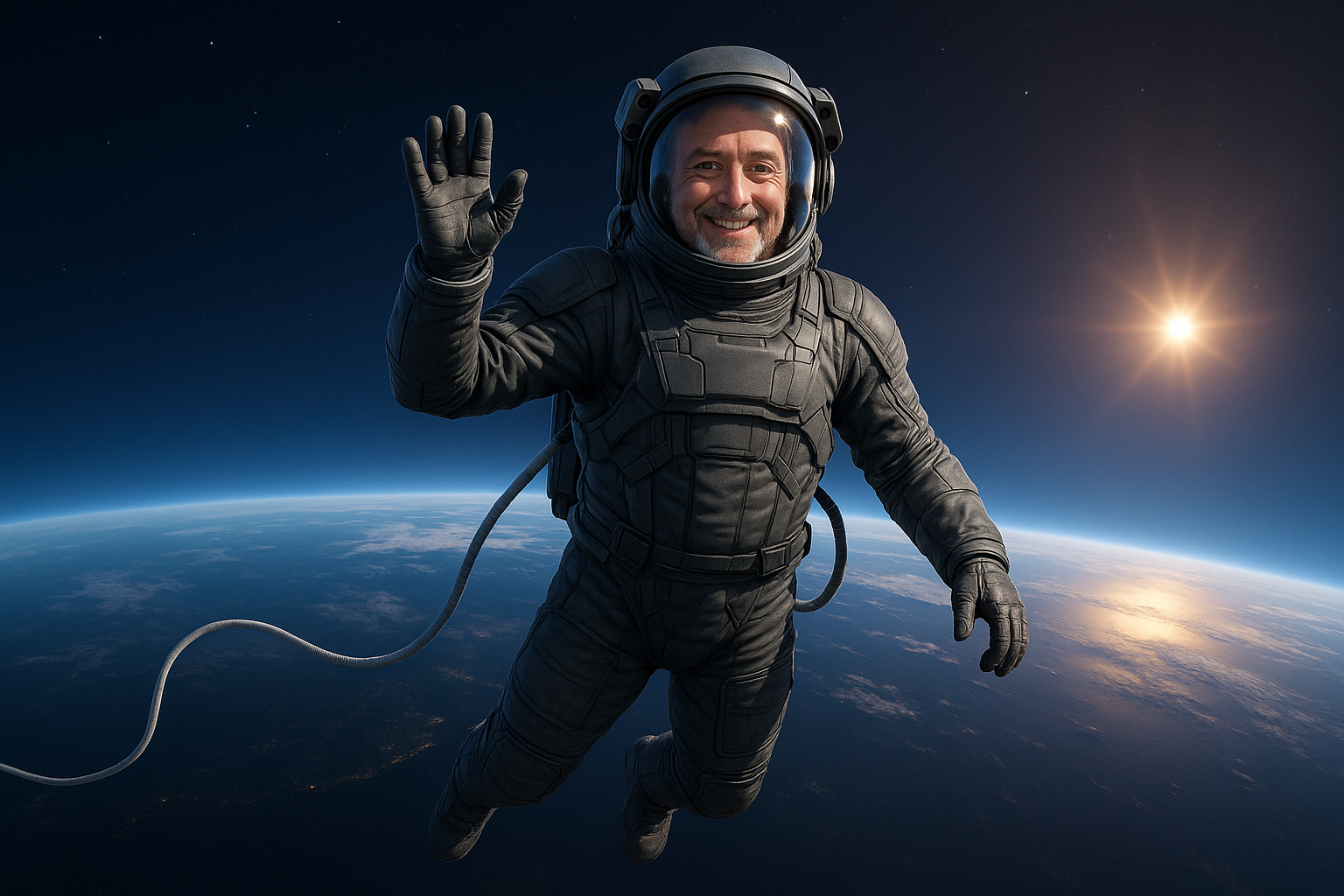
When I first announced the Strands Movie project back in May, I was excited about the recent advances in AI video generation tools, and I emphasized that the project would be largely driven by AI video. Since then, I’ve spent a good deal of time working with AI video and image generation tools, and the lack of content on the Strands Movie project is all you need to see to get a sense of how that has gone.
At this point, I have recalibrated my expectations about AI video generation, and about AI in general. Ever since OpenAI introduced ChatGPT at the end of 2022, I would put myself in the
‘AI Optimists’ camp, as opposed to the ‘AI Doomers’.
The Doomers, led by people like Elizier Yudkowski and Max Tegmark, claimed that AI advances were happening so quickly that its intelligence would certainly outstrip Humanity’s collective intelligence before we have the chance to fully understand it, let alone master it. Furthermore, their expectation is that such an Artificial Super Intelligence (ASI) will be more likely to see Humanity as the source of all the problems in the world and that eliminating us, reducing our numbers, or otherwise controlling us is the solution.
Even if it doesn’t go that far, AI combined with robots and drones will be more capable of doing every job in the world, rendering humans obsolete.
The Doomers see this outcome as inevitable as long as we continue to develop AI, so we need to stop or slow down the development process now. The Future of Life Institute led by Tegmark recently released a Statement on Superintelligence calling for the prohibition on the development of superintelligence that has been signed by a wide range of prominent scientists and thought leaders.
The AI Optimists, on the other hand, assume that once we’ve achieved Artificial General Intelligence (AGI), humans will work together with AGI to develop ASI very quickly. At that point, we’ll have all the intelligence we need to solve all the problems that have proven to be so intractable for us. ASI won’t need to eliminate Humanity (the source of all the problems) because all the problems will be resolved.
BTW, if you aren’t clear on the definitions of ASI or AGI, you’re not alone. There are no clear or generally accepted criteria for those definitions. But roughly, AGI would be when any given AI tool is more intelligent than the most proficient human in any given field. ASI would be when AI is more intelligent than the entire human population collectively.
I still align myself with the AI Optimists, simply because I believe that in the long-term, things get better. (Would you want to go back and live in caveman days? How about the dark ages? Me either.) But my position has evolved over the last few months.
Today, I’d like to share my thoughts on the current status of AI development. It’s a pretty intense take.
Then I’ll wrap it up by covering how it all applies to the Strands Movie project.
As messed up as our world is currently, it is still better than it’s ever been before. Moreover, we are poised on the edge of being able to turn our world into a utopia if, and only if, we can harness the power of ASI for our collective benefit. So yes, I’m an optimist. But I also know that things don’t generally flow in a nice predictable line. I think we have one more great challenge ahead of us over the next few years before we can make it to the promised land of peace and prosperity.
Like I said, my opinions have evolved over the last few months after many hours of working with various AI models. Based on my experience, I can tell you with confidence that we have not achieved AGI yet.
As remarkable as AI tools are currently, they are basically still dumb, mechanistic systems. They are incredible mimics, but they don’t understand what you or they are saying. They don’t have the capacity to have a meeting of the mind with you, or really understand what it is you are looking for. They can only respond based on the exact prompts you give them applied to everything they’ve learned through their training so far.
The emerging field of Prompt Engineering is based on the fact that we need to carefully craft our instructions to these Large Language Models (LLMs) and generative AI models (GenAI). Prompt Engineers are like the old school programmers on the original computers — figuring out how to feed data into the system in order to get more useful data back. But the system we are feeding data into now has become so sophisticated and abstracted that the process of how it determines its output is too complicated for us to track.
But just because the process is too complicated for us to track, doesn’t mean it is complex enough to morph into a generally conscious entity.
OK, that was all pretty abstract. Let me give you a concrete example to illustrate what I’m talking about.
I was just working on membership levels on my Patreon and Buy Me a Coffee pages, and I needed an image for each one of them. I thought a fun idea would be to extend the picture I put on the home page of my website with me as an astronaut. So I hopped onto ChatGPT 5 to whip out a couple more quick versions.
Quick caveat: I don’t claim to be the best prompt engineer. So showing the gyrations I go through is as much a reflection of my lack of skill as it is ChatGPT’s lack of consciousness.
The first version of the image was actually pretty decent. My prompt was:
Take this last version of the headshot and show him in outer space with Earth in the background, waving at the camera. Give him a somewhat bigger smile.

I didn’t expect the headshot to look just like me, but it is a guy who could pass for me. The problem I had with this one was that I’m in space with no helmet. You see, AI doesn’t understand enough to know that if a man is in space, they need a helmet with their space suit. AGI would not make a silly mistake like that.
But we just have ChatGPT 5 right now, so I modified my query to:
Let’s put him in space as if he is actually in space. His helmet is on, and the position of the sun is such that we can clearly see his face behind the visor. We can also see the Earth below him, as we see a full body shot of Dane floating in space, with tether extending from his life support.

This one actually resulted in a pretty great result. Again, it’s OK that his face only looks similar to mine. In fact, the only thing I didn’t like about this one was that he had a black suit, and I wanted him to have a white suit. So I created the following prompt:
Very good. Let’s put him in the white space suit. Also, let’s see the moon, sun, and milky way in the background.

This time, it got the space suit, the moon, and the milky way right. The main problem with this one was it significantly changed the face so it doesn’t resemble me nearly as much.
So I gave it another try, hoping that we were narrowing in on the right shot.
That last one is pretty good, except the face doesn’t look so similar to the original upload model. Can you try one more time, making it just like this, but try to get Dane to look closer to the upload.

This prompt got me so close to what I was looking for. But then, the more I looked at it the more it seemed like my head was out of proportion. Too big, right? So I thought I’d just make this one more tweak, with this sloppily-worded prompt.
This image that you create of me is just about perfect, but doesn’t my head look too big? And try to make it look more like me in the original headshot I uploaded.
In response to that prompt, ChatGPT produced this one, with an even bigger head.

I made several attempts to try to get ChatGPT to simply put my head in proportion, but it was stuck, and just kept producing images with oversized heads that looked less and less like me.
The point of this exercise is to demonstrate that AI is not close to AGI currently. I won’t belabor the point any further. I think it’s pretty clear.
So OK, AI is not yet AGI. But it’s still a pretty useful tool, right?
I would say that it is a very useful tool for certain use cases, such as doing research and bouncing ideas around. But when it comes down to getting actual, productive work done, AI is more of an obstacle than an asset. According to recent reports cited by Trullion and the Harvard Business Review, 95% of Generative AI pilots fail to produce measurable financial impact. In other words, AI isn’t making people more productive. In fact, people are having to put extra effort into working around AI’s lack of capability.
It’s kind of like having to work with a toddler or a small child. They don’t understand the big picture and they can’t contribute much to accomplishing the goal. They are learning, and some day they’ll be very productive, but for now, you have to spend more time minding them than they are worth.
And here we come to my particular take on this situation. I don’t see how AI is going to be a net contributor to productivity until it achieves AGI capabilities. Until then, GemAIs are just going to generate greater and greater quantities of AI slop, while LLMs continue to crank out terabytes of banal AI copy that doesn’t reveal a scintilla of meaningful insight. It will be a net drain on our productivity and our resources until it has achieved maturity, i.e. AGI status.
The question is, when will we get to AGI? How soon is that coming? The estimates are across the board, with some claiming we’re flirting with it now, and others saying it could be several years away.
Everything hinges on this question.
I have many thoughts on this question, but this article has gotten quite long, so I’ll need to tackle those in a follow-up.
I want to wrap up by covering how my changing perspective applies to the Strand Project. I still intend to keep experimenting with the video gen AI models as they progress, more as a way of sharing ideas than to try to actually generate usable video. And I hope to collaborate with people who are further along the path at mastering the use of AI video.
But I want to place the emphasis on ‘collaboration’ — not on AI. Humans are still the only entity capable of creating quality, compelling video using the amazing video production tools we have at our disposal. They are the ones I really want to collaborate with.
But while I can get ChatGPT to collaborate with me for $20/month, finding human collaborators is not so easy. The only way to do that is to raise my profile.Please consider supporting the Dane of Earth and/or Strands project on Patreon or Buy Me a Coffee. And of course, Likes, Shares, Subscribes, and Comments are greatly appreciated!
